
 The newsletter of NASA's Radio JOVE Project
The newsletter of NASA's Radio JOVE Project"Solar and Planetary Radio Astronomy for Schools"

 The newsletter of NASA's Radio JOVE Project
The newsletter of NASA's Radio JOVE Project

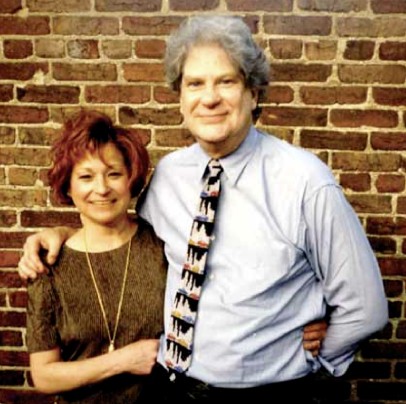
On October 15, Kathleen Franzen, the President of The INSPIRE Project, passed away after a brief illness. Kathleen was many things - a scientist was not one of them - and she would never claim to be one. You may wonder how it was that a non-scientist became the President of the Interactive NASA Space Physics Ionosphere Radio Experiment (INSPIRE) Project. Kathleen stepped into this role in 2005 when her husband of many years, William (Bill) Taylor, INSPIRE President and co-founder, passed away unexpectedly.
Non-scientist that she was, Kathleen had a vision of making The INSPIRE Project something more than it had been. Over the past 5 years, this is what she set out to do. From expanded marketing and fund raising, scholarships, grants to send teachers to Space Camp, through to increasing the sales of the lightning detection VLF receiver kit upon which the program is based, the INSPIRE Project did all these things and more under her fearless leadership. With Kathleen's passing, The INSPIRE Project has taken a huge hit, but a band of volunteers has agreed to continue the program because of the good we believe it can do for science education. If you would like to become involved with The INSPIRE Project, we are always looking for volunteers to help in any way they can. We can be contacted via The INSPIRE Project website (http://theinspireproject.org/). Please come and join us as we take The INSPIRE Project onwards into the future, doing so in the memory of Kathleen and Bill.
Phillip Webb (Acting President, The INSPIRE Project)
[Editor's Note: Bill Taylor, Kathleen's husband, was also a co-founder of the Radio Jove project. He and Bill Pine started the INSPIRE project. The two Bills were very helpful in getting the Radio Jove project started based on the methods that had been used for INSPIRE. Bill Pine distributed the INSPIRE kits for many years, and also served as the Radio Jove kit distributor for a number of years. Radio Jove owes much to INSPIRE, Bill Taylor, Bill Pine, and Kathleen Franzen for help all along the way.
For more information about Bill Taylor see the INSPIRE Journal Volume 14 December 2005 (14 MB PDF)
http://theinspireproject.org/index.php?page=journal_archives]
In these times when the urge to gather more information about the universe and even beyond is multiplying with each passing day, the IEEE student branch of Maharaja Surajmal Institute of Technology (MSIT) affiliated to Guru Gobind Singh Indraprastha University, organized and presided over a Solar Observation and Astronomy session. The observations were in furtherance of the Radio Jove Project.
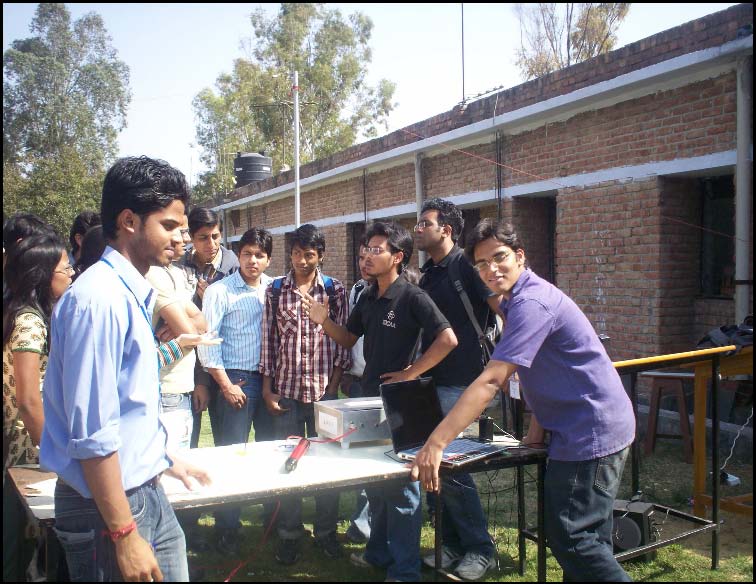
The observing session threw ample light on the effectiveness of Radio Jove. The Radio Jove kit is used to monitor the Sun and Jupiter at a frequency of 20 MHz. The observing session included a number of experiments with optical telescopes, spectroscopes and other astronomical activities. Radio observations were conducted on the college grounds. The set up consisted of a Radio Jove receiver, dipole antenna, a laptop and speakers.
The session was accompanied by questions from students and print media personalities. Around 6 newspapers both English and Hindi published articles on the effectiveness of Learning using the Radio Jove equipment.
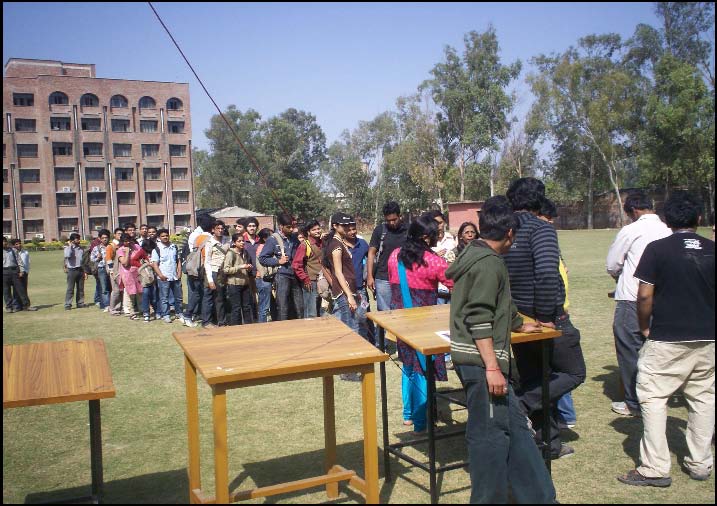
The observing session was held on the college grounds of MSIT, and drew nearly 300 students from GGSIP University, the Delhi University as well as the Delhi Technical University.
Solar observations were followed by a talk by Mr Preshanth Jaganathan scientific officer of SPACE (Science Popularization Association of Communicators and Educators) on “Basic Astronomy”. Students were given an overview of different fields of Astronomy. Interaction was followed by questions from students. This was the first event in GGSIPU affiliated college and students enjoyed the event. Thus, the episode was in every sense an astronomy lover’s delight.
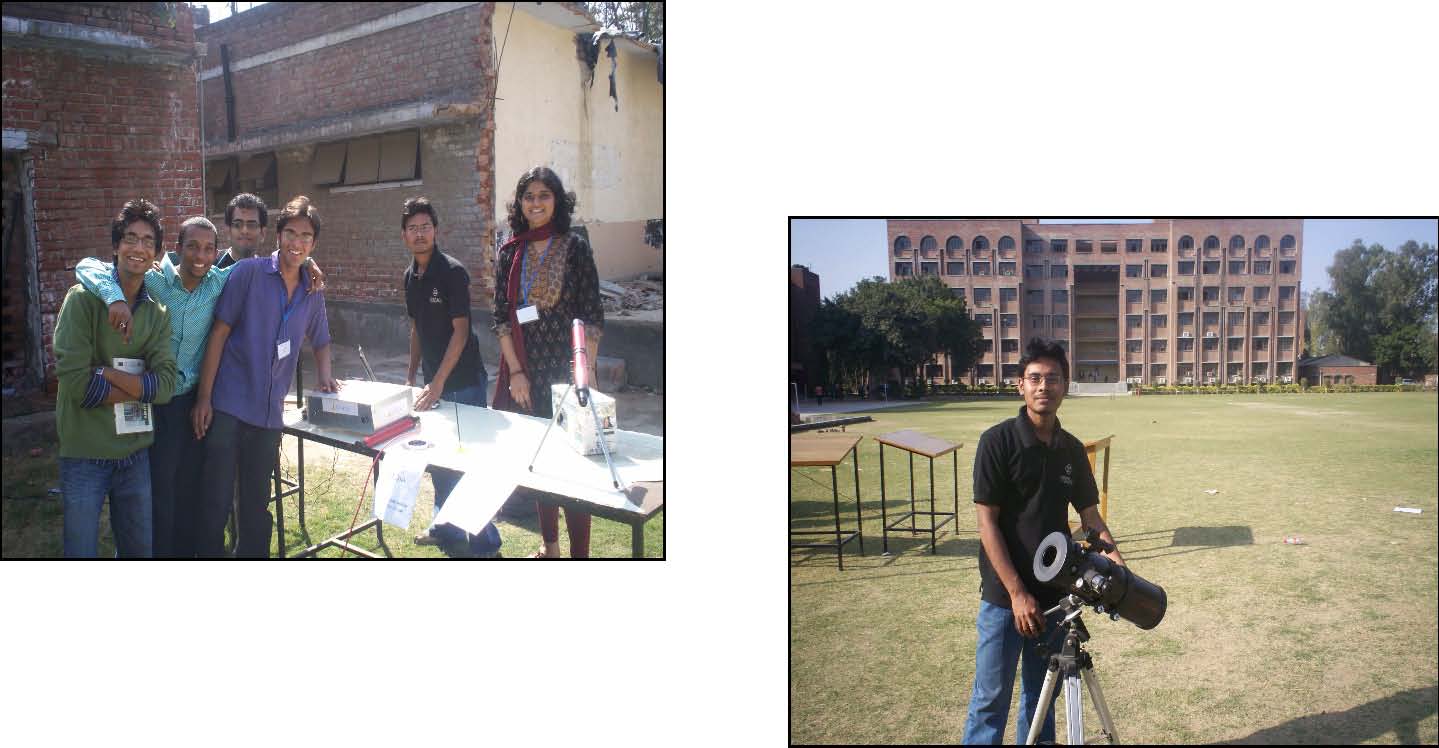
I thank SARA (Society of Amateur Radio Astronomers) for providing me a Radio Jove kit as an award. Assembling the Jove kit is always fun. I simulated the Jove receiver using different simulation tools (like ADS) noting the performance gain after every stage. I assembled the kit at the Electronics Science Department, University of Pune. I also developed a loop antenna for Radio Jove which can be used to listen to Jupiter and the Sun.
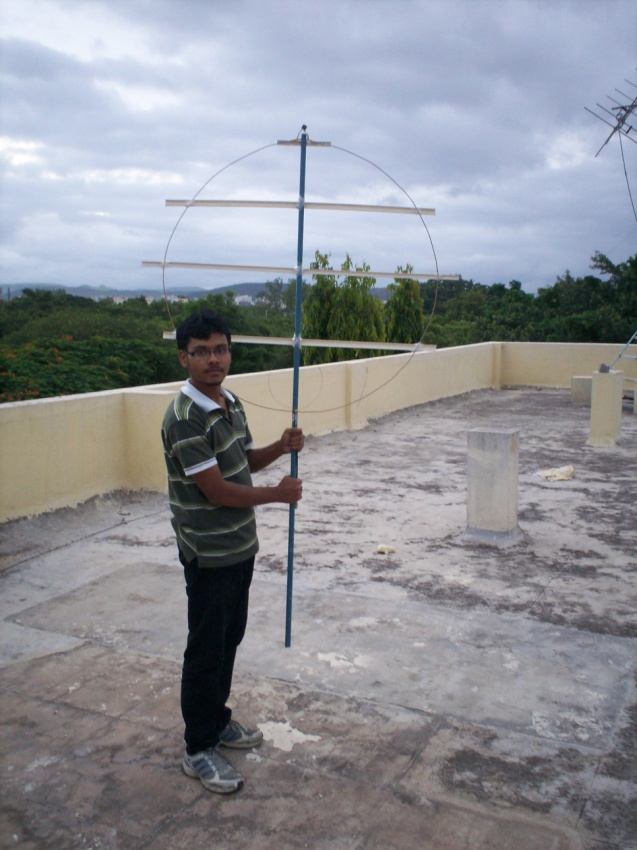
The loop antenna has been simulated, fabricated and tested in the lab.
Simulation of the loop antenna using NEC-2 software gives the following results:
I want to thank SARA, NASA, Professor Subramaniam Anathakrishnan, Dr Victor sir, Dr R.K Tewari, Mr Amit Kadian, Divyadarshan Purohit, Dr Jim Thieman, my mentors Richard Flagg and Wesley Greenman and other group members for their help and support at every step of my work.
[ Editor's Note: A side by side comparison with a standard Jove antenna and a small loop would be an interesting experiment and we hope that Tushar will do that. Past experiments observing Jupiter with similar small antennas have yielded disappointing results. ]
Divyadarshan D. Purohit from Gurudev Observatory, Vadodara, India sends us this update:
Dear Friends,
All India Radio (AIR) is an Official Radio Broadcaster of the Government of India and is well known as "AkashVani" (Speech of the sky). It is a great honor for one to give a talk on AIR. Over 0.8 Billion people all over India listen to it.
Last year I had been invited to talk on "Research on radio waves from Jupiter" on the basis of our work with the Radio Jove project and the gift received from SARA. The contract was for six months. That talk show was for 10 minutes and was a great success. Based on this, I have been invited by AIR again to talk on "Solar storms, their cause and remedies to save the earth from them". This is based on our work with Super SID and Radio Jove.
This talk was 7 minutes long and has been recorded at the AIR studio at Vadodara on November 10, 2010 and will be on AIR on November 24, 2010. It will be heard during the "Vigyan Bharati karyakram" (i.e. Indian Science programme) and will be relayed from the Indraprasth Channel of AIR from New Delhi between 10 to 10:30 P.M. (IST) on November 24, 2010. This will be broadcast by AIR all over India and through the world with the help of DTH (direct-to-home) signals. This contract is for six months and signed by the station director on behalf of the President of India.
Please kindly listen to the talk, (it is in Indian National Language Hindi, because AIR reaches in remote places where most of the listeners could not understand English) and send me comments so that I can further improve these talks.
with kind regards,
DDPurohit
--
Divyadarshan D.Purohit
Gurudev Observatory,
Vadodara
India
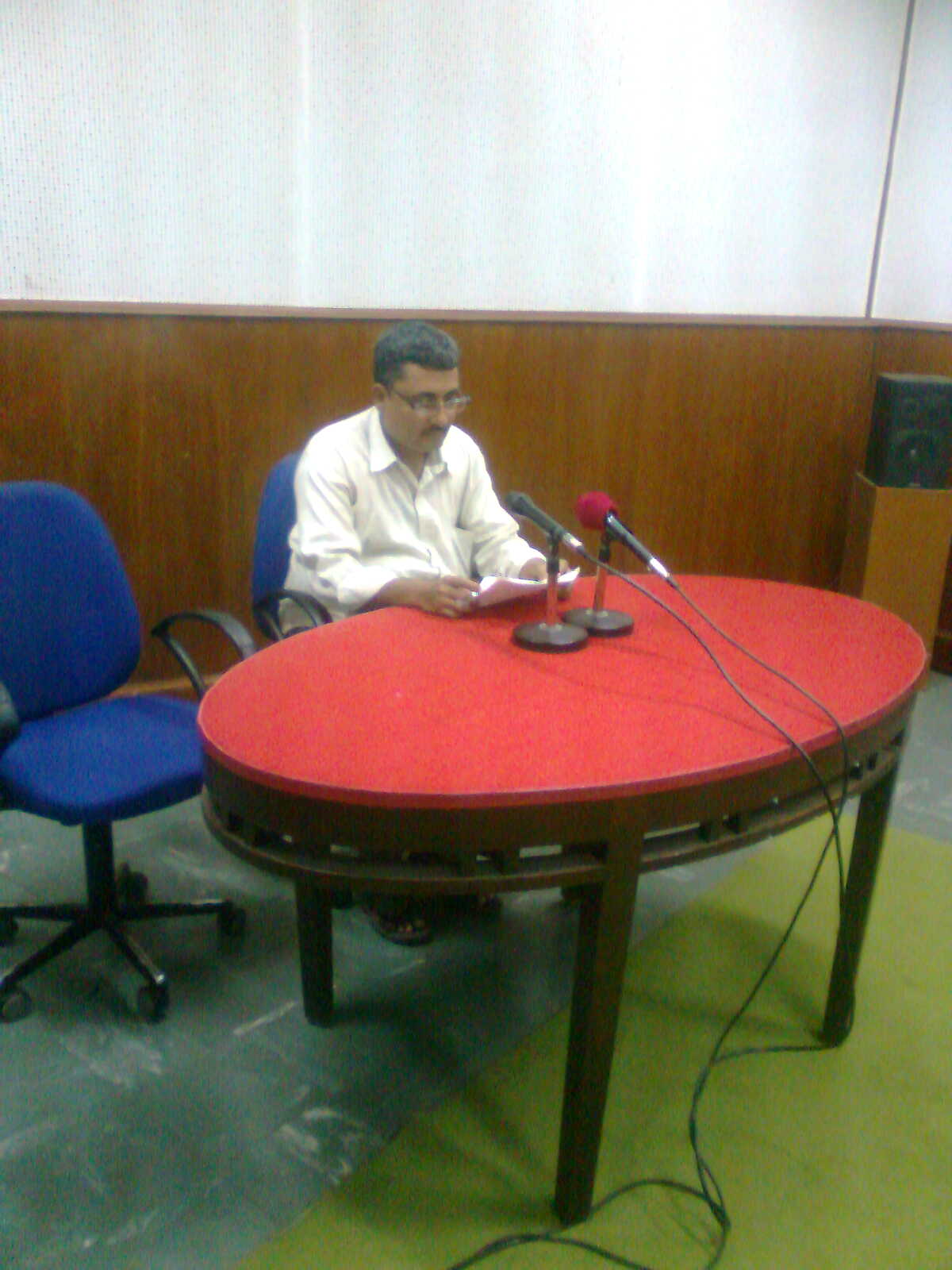
Faraday lanes are often observed in radio spectrograms of Jovian emissions. These lanes appear as horizontal bands of activity (Figure 1). As you move vertically (in frequency) the pattern appears alternately as bands of emission separated by bands of weaker (or no) activity. This phenomena is observed with a linearly polarized antenna, when Jupiter is emitting linear polarized signals. Because the plane of the signal electric vector changes with frequency, at some frequencies it is parallel with the antenna polarization plane (signal maxima), while at other frequencies it is perpendicular to the antenna polarization plane (signal minima).
The Faraday effect is the result of signals splitting into two different propagation modes – each with a different refractive index (and hence slightly different propagation velocities). The magnitude of the effect is influenced by both the magnetic field and electron density along the propagation path. It is believed that most of the Faraday rotation imparted to Jovian signals takes place in the Earth's ionosphere.
Wes Greenman (Radio Alachua) and others received good signals during the 28 October 2010 Io-B storm. Using Wes's spectrograph record (UFRO machine running 200 channels) and a calibration record, my goal was to make a plot of the Faraday lane intensity (antenna temperature vs frequency at one particular time).
The technique was to save a small segment of the spectrograph data file (where the lanes looked quite strong) as a CSV file and import it into Excel. Activity occurring within the limits of the CSV file is seen in Figure 1.
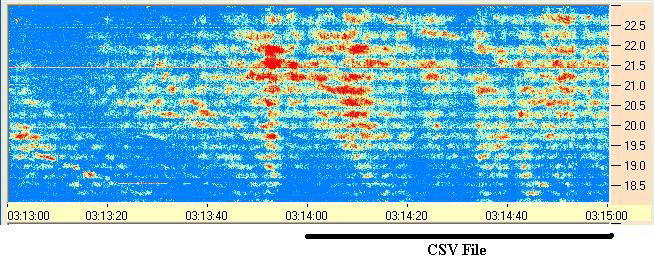
Wes also ran a noise source calibration of the spectrograph producing known temperatures every 2 dB between 6.68 x 103 and 6.68 x 106 degrees (Figure 2). This data was used to convert the spectrogram intensity data represented by colors in figure 1 into temperatures.
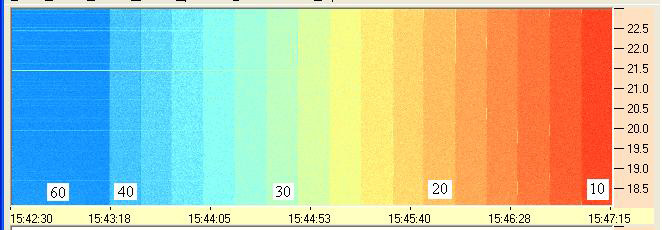
Next I took the calibrated CSV storm data file and averaged 39 consecutive time scans and 3 adjacent frequency channels to obtain the data plotted in figure 3. Averaging was done to reduce noise fluctuations. (Don't ask why I picked 39 scans vs some other number).
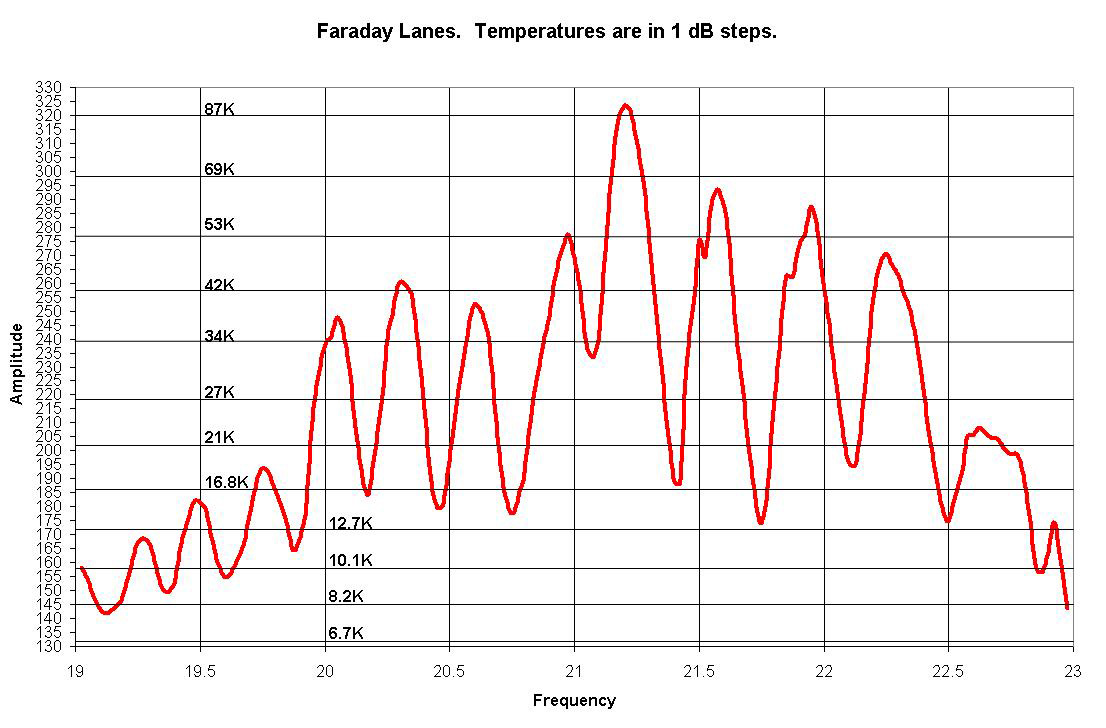
As expected, the Jove antenna does not deliver a constant background temperature across the spectrograph frequency span. Decreased sensitivity is seen near the high and low ends of the intensity vs frequency plot. The minima are quite deep suggesting a high percent of linear polarization.
Near 19 MHz, minima are separated by 224 kHz and near 22.5 MHz the separation is close to 389 kHz.
The presence of Faraday lanes can impact observations made with a Jove receiver. If you are tuned near a Faraday maximum frequency then you may receive strong Jovian signals, while another observer might be tuned to a minimum frequency just a couple of hundred kilohertz away and get nothing. The frequencies where the maxima and minima occur change from storm to storm and sometimes are seen to drift slowly across the spectrum during a single storm.
Additional analysis is planned - in particular to compare the lane minima separation with theory.
Once each year the Virginia Association of Astronomical Societies, (VAAS), holds its annual conference hosted by a member club. The 2010 conference was held on the campus of Roanoke College in Salem, Virginia, on October 9th. The gathering was sponsored by the Roanoke Valley Astronomical Society, (RVAS), and the Roanoke College physics department.

The main program commenced at 9:30 AM with a presentation on the NASA educational outreach program, Radio Jove. Dr. Jim Thieman from the Goddard Spaceflight Center in Greenbelt, Maryland was the speaker. His presentation was well put together and was well received by the audience of over 60 amateur astronomy enthusiasts from around the state.
A working Radio Jove station was set up to demonstrate the simplicity and portability of the system. The antenna was a single dipole modeled after the RJ1 antenna and mounted using 10 foot PVC supports fastened to the railing on a balcony on the rear of the building. Unfortunately, but not totally unexpected, there was very strong RFI in the vicinity which precluded making any useful observations, but did suffice as a demonstration of the system.


I believe this was one of the first VAAS conferences where amateur radio astronomy was a major part of the program. There were several individuals that expressed interest in Radio Jove. Hopefully this planted a seed that will result in the further growth of the Radio Jove program and amateur radio astronomy in general.
Francesc Bersunses has launched, along with amateur astronomers and other space fans, a website that provides astronomical information updated on an ongoing basis.
The web site at http://www.radioastronomiacalafell.com in cooperation with NASA's Radio Jove project will enable science buffs around the world to collaborate on the observation and analysis of radio emissions from Jupiter. This site, from the city of Calafell in Spain, was officially launched at a ceremony before the city council in which Dr. Josep Maria Torrelles, a teacher and researcher at the Institute of Space Sciences, University of Barcelona was the guest of honor. According to Torrelles, "scientific discovery and communication is essential to our society. Sometimes, you think that science is not culture, but this is not the case." He added that "this site teaches the public about the Radio Jove project and may encourage many people, especially youth, to get excited about investigating the universe through radio waves. " Francesc added that "the project aims to make a cultural outreach and make Calafell a scientific reference point to the world."
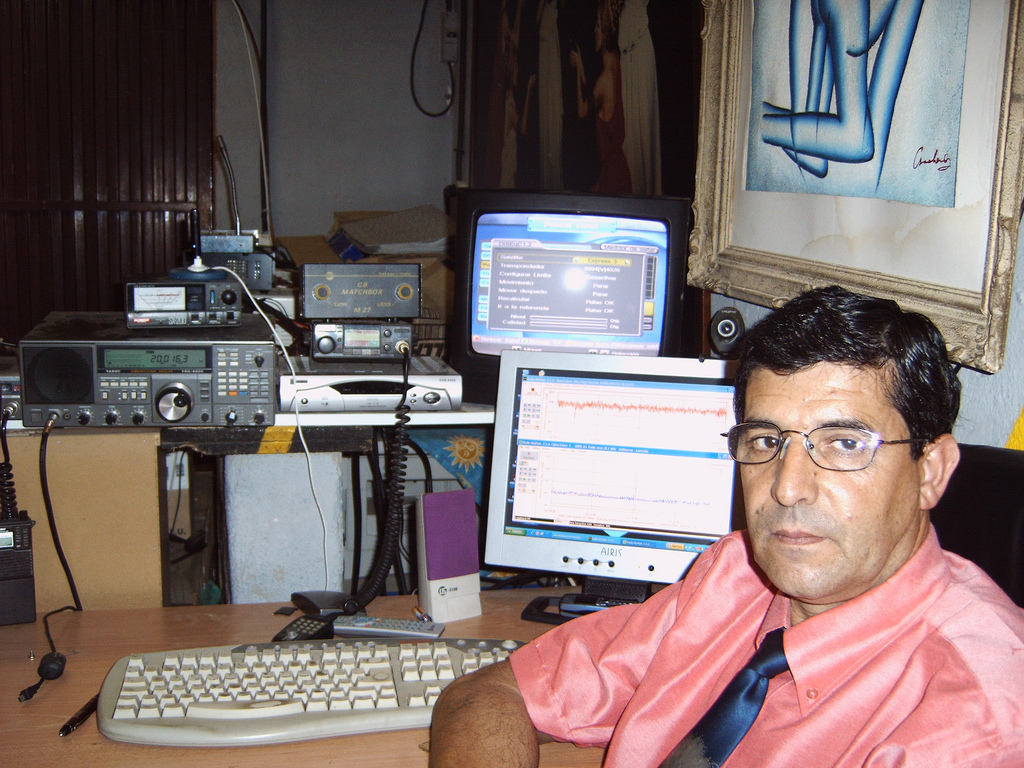
The JOVE Bulletin is published twice a year. It is a free service of the Radio JOVE Project. We hope you will find it of value. Back issues are available on the Radio JOVE Project Web site, http://radiojove.gsfc.nasa.gov/
For assistance or information send inquiries to:
or
